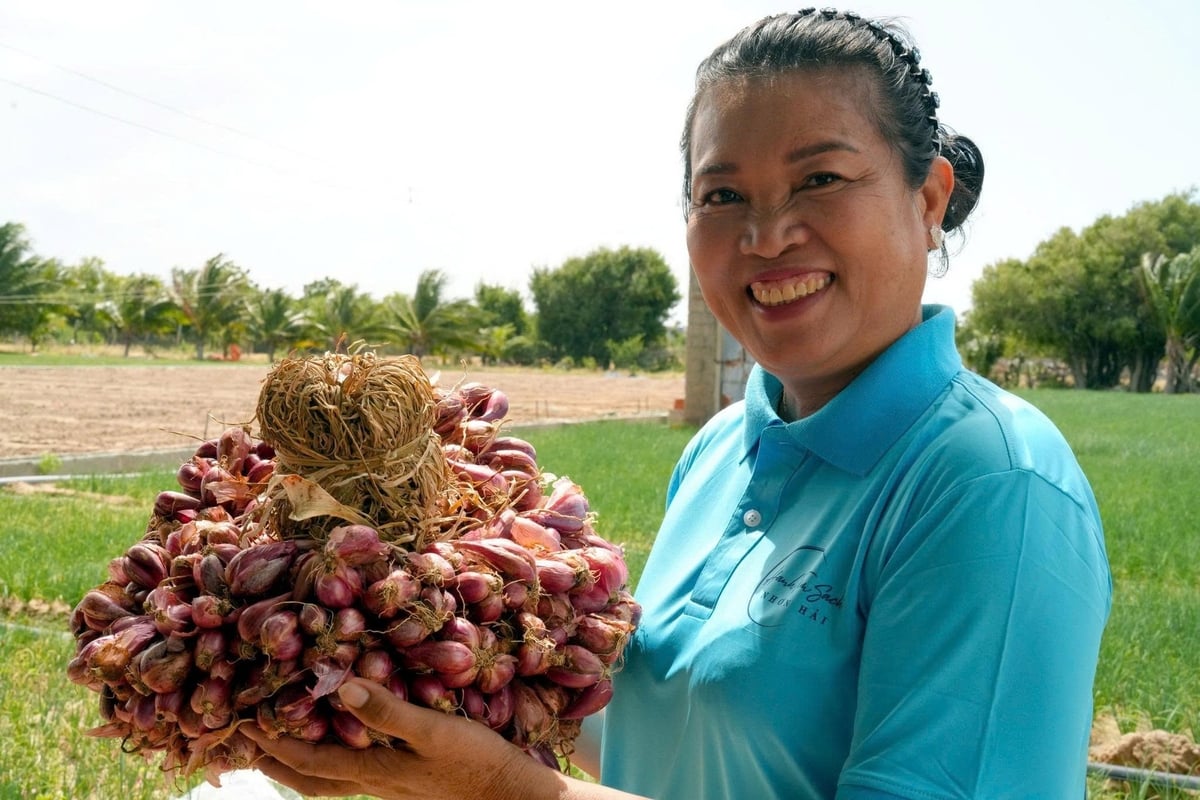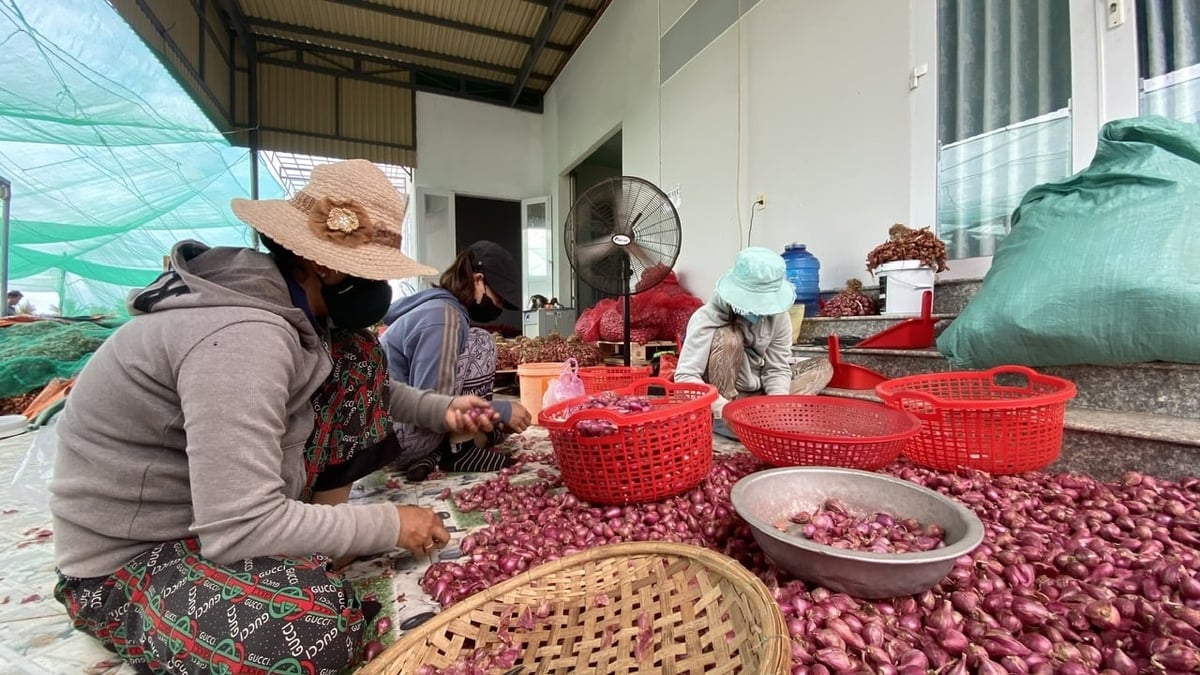November 12, 2025 | 08:15 GMT +7
November 12, 2025 | 08:15 GMT +7
Hotline: 0913.378.918
November 12, 2025 | 08:15 GMT +7
Hotline: 0913.378.918
Ms. Nguyen Thi Chau – Director of Nhon Hai Purple Shallot Agricultural Cooperative, comes from a purely agricultural family, toiling year-round in the sandy coastal area of My Tuong 1 hamlet, Vinh Hai commune (Khanh Hoa). This region is famous for its shallots and garlic, but the repetitive cycle of "good harvest, low price; good price, poor harvest" made Ms. Chau determined to establish the cooperative.

Ms. Nguyen Thi Chau – a key contributor to the development of production, consumption, and export of Ninh Thuan (formerly) purple shallots. Photo: Nguyen Co.
The Nhon Hai Purple Shallot Agricultural Cooperative was officially established on August 22, 2022, with Ms. Nguyen Thi Chau serving as Chairwoman of the Board of Directors and concurrently as the Director. From the outset, the cooperative was modest in scale, comprising only 8 founding members, most of whom were women. Their shared aspiration was to produce high-quality shallots with a stable market, create additional employment opportunities, and improve livelihoods for local farmers in the region.
Over time, the cooperative has expanded significantly, now boasting 23 members and an operational fund exceeding VND 1.5 billion (approximately USD 60,000). The cooperative currently supports and sources shallots from around 14 hectares of farmland, all of which have been granted official planting area codes. Annual production reaches over 10,000 tons. The cooperative's purple shallot products have achieved a 4-star OCOP (One Commune One Product) rating and have been certified with planting area and packaging facility codes required for export. In recent months, the cooperative has begun exporting its products to foreign markets such as Japan and Indonesia, with a steady weekly shipment volume of around 3 tons. It is the first unit in (former) Ninh Thuan to successfully export purple shallots.
Currently, the (former) Ninh Thuan province has approximately 1,500 hectares of land dedicated to the cultivation of onions, garlic, and other spice crops. Of this, purple shallots cover about 700 hectares, with the largest concentrations found in Thanh Hai, Nhon Hai, and Vinh Hai communes in the (former) Ninh Hai district. Purple shallot farming has become not only a traditional agricultural practice but also the main source of income for many farming households in the area.
The purple shallots grown in this region are prized for their vibrant color, smooth and glossy skin, large and firm bulbs, distinctive pungent aroma, and excellent storage qualities. With four growing seasons per year and a cultivation cycle of 60–70 days from planting to harvest, the crop is available year-round, allowing producers to meet the demands of both domestic and international markets.

Purple shallot farming has become a traditional livelihood and the main source of income for farmers in the former Ninh Hai district. Photo: Nguyen Co.
Ms. Chau shared: “At first, I faced many difficulties, from finding quality raw materials to researching drying and packaging methods, and building a brand. I knew the local shallots had great potential, but developing them in a professional and methodical way was no small challenge.”
Thanks to her achievements in agricultural production and contributions to local development, Ms. Chau has been honored with numerous certificates of merit and commendations from various levels, sectors, and local authorities.
Undeterred, she dedicated much time to learning and gaining experience through trade fairs, exhibitions, and promotion events across the country. In addition, she quickly absorbed knowledge from agricultural experts on VietGAP-standard production and practiced climate-resilient farming techniques. Her efforts were warmly supported and followed by fellow members of the cooperative.
Ms. Chau further shared: “In the beginning, many local farmers were still quite reluctant because they were used to planting 4–5 shallot crops a year. During the dry season, when water is scarce, they either wouldn’t produce at all or would try to keep growing despite the conditions, which often resulted in low-quality shallots and high input costs. It wasn’t easy to convince them to change their long-standing practices. But once they saw the actual benefits of the intercropping model - growing shallots in rotation with peanuts and mung beans - implemented right on the cooperative’s land, more and more people began to pay attention and gradually followed the new approach.
I also have a strong desire to purchase the rotational crops from our members, so they feel secure and confident in their production. Crop rotation not only improves soil fertility and reduces pests and diseases for future shallot crops, but also helps the cooperative actively manage its raw material sources. This creates more stable jobs and contributes to increasing farmers’ incomes in a sustainable way.”
Translated by Phuong Linh

(VAN) From humble local delicacies, many businesses in the Mekong Delta have successfully conquered domestic and international markets with their distinctive One Commune One Product (OCOP) goods, contributing to sustainable rural economic development.

(VAN) The Vietnamese tilapia industry is only in the initial stages of export, yet its growth potential remains vast. To reach further, it needs to focus on breed stock, technology, and deep processing.
/2025/11/08/3402-1-212706_176.jpg)
(VAN) Viet Nam's fruit and vegetable exports continued to reach an extremely high turnover in October. With this growth momentum, the sector is expected to set a new milestone of USD 8.5 billion in 2025.
/2025/11/08/4950-1-163820_289.jpg)
(VAN) During the 2021–2025 period, Viet Nam's agro-forestry-fishery processing industry has made remarkable progress, achieving an average growth rate of 8%/year.

(VAN) Over 80 years, Vietnamese rice has journeyed through half a century to become a symbol of knowledge, resilience, and the new nation’s agriculture stature.

(VAN) The traders estimated that the lowest price in the tender, closed on Thursday by Bangladesh's state grain buyer, to buy 50,000 metric tonnes of rice was $355.59 per metric ton CIF, liner out.

(VAN) The information shared by Dr. Ngo Xuan Nam, Deputy Director of Viet Nam Sanitary and Phytosanitary Notification Authority and Enquiry Point (SPS Viet Nam), on October 30 during a conference on food safety regulations.